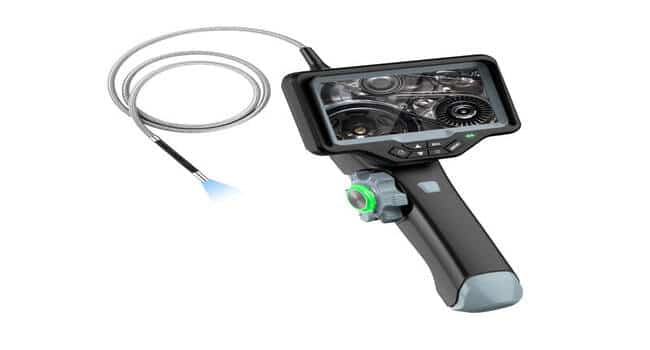In the realm of modern engineering and industrial maintenance, the ability to peer into inaccessible spaces with precision and clarity is paramount. This capability is precisely what 4mm borescopes offer, revolutionizing inspection processes across a myriad of industries. From automotive maintenance to aerospace engineering, these slender yet powerful tools provide invaluable insights into the inner workings of machinery, pipelines, and structures. In this comprehensive guide, we delve into the workings, applications, advantages, and future prospects of 4mm borescopes.
What Do You Mean By 4mm Borescopes?
At the heart of a 4mm borescope lies a sophisticated optical system designed to capture high-resolution images and videos in confined spaces. Unlike traditional inspection methods that often involve disassembly or expensive machinery, borescopes for sale offer a non-destructive and cost-effective means of visual inspection. The slender 4mm diameter allows these devices to navigate through narrow passages, intricate machinery, and even within the human body for medical applications.
The primary components of a 4mm borescope include a flexible insertion tube, an imaging sensor, lighting sources, and a control unit. The insertion tube, usually made of durable materials like tungsten or stainless steel, houses the optics and can be manipulated to navigate bends and corners effortlessly. Meanwhile, the imaging sensor captures detailed visuals of the inspection area, which are then transmitted to the control unit for real-time viewing or recording.
Applications Across Industries:
The versatility of 4mm borescopes makes them indispensable tools across a wide range of industries. In automotive maintenance, mechanics utilize these devices to inspect engines, transmissions, and exhaust systems without dismantling components. By identifying potential issues such as corrosion, leaks, or blockages early on, maintenance teams can prevent costly breakdowns and ensure optimal performance.
Similarly, in the aerospace industry, where safety and reliability are paramount, borescopes play a crucial role in inspecting aircraft engines, fuel lines, and structural components. By conducting thorough visual inspections, engineers can detect signs of wear, fatigue, or foreign object debris (FOD) that could compromise flight safety.
Moreover, 4mm borescopes find applications in the manufacturing sector for quality control and defect analysis. Whether inspecting welds, castings, or electronic components, these devices enable inspectors to identify imperfections with precision, ensuring adherence to strict quality standards.
Beyond traditional industrial uses, 4mm borescopes have made significant inroads in the medical field. Endoscopes, a type of borescope adapted for medical purposes, facilitate minimally invasive procedures such as arthroscopy, laparoscopy, and gastrointestinal examinations. With their slender profile and advanced imaging capabilities, medical professionals can diagnose and treat a variety of conditions with minimal discomfort to patients.
Advantages of 4mm Borescopes:
The adoption of 4mm borescopes offers numerous advantages over conventional inspection methods. Firstly, their non-destructive nature eliminates the need for dismantling equipment or structures, saving both time and resources. This also minimizes downtime, allowing for uninterrupted operations in critical industries.
Furthermore, the high-resolution imaging capabilities of 4mm borescopes ensure detailed visual inspections, enabling inspectors to detect even the smallest defects or irregularities. Whether assessing the integrity of welds, identifying foreign objects in pipelines, or examining internal organs, the clarity of imagery provided by these devices enhances diagnostic accuracy and decision-making.
Additionally, the flexibility and maneuverability of 4mm borescopes allow for inspections in confined spaces and complex geometries that would otherwise be inaccessible. This versatility extends their utility across a wide range of applications, from automotive maintenance to aerospace engineering, ensuring comprehensive inspection coverage in diverse environments.
Future Prospects and Innovations:
As technology continues to advance, so too do the capabilities of 4mm borescopes. Ongoing developments in miniaturization, optics, and imaging sensors promise even greater precision and performance in future iterations of these devices. Enhanced imaging resolutions, extended reach capabilities, and integrated artificial intelligence algorithms for automated defect detection are just some of the innovations on the horizon.
Moreover, the integration of wireless connectivity and remote operation features allows for greater flexibility and accessibility in inspection workflows. With the ability to transmit real-time visuals to remote locations, inspectors can collaborate seamlessly across geographical boundaries, improving efficiency and decision-making in inspection processes.
Furthermore, advancements in materials science may lead to the development of even more durable and lightweight insertion tubes, further expanding the range of environments in which 4mm borescopes can be deployed. Whether exploring deep within machinery or navigating intricate pipelines, these innovations promise to push the boundaries of inspection capabilities to new heights.
In conclusion, 4mm borescopes represent a transformative technology that has revolutionized inspection processes across industries. From their ability to navigate confined spaces with precision to their high-resolution imaging capabilities, these devices offer unparalleled insights into the hidden depths of machinery, pipelines, and structures. The abilities of 4mm borescopes will continue to grow along with technology, making them useful and relevant in the ever-changing field of industrial inspection.
